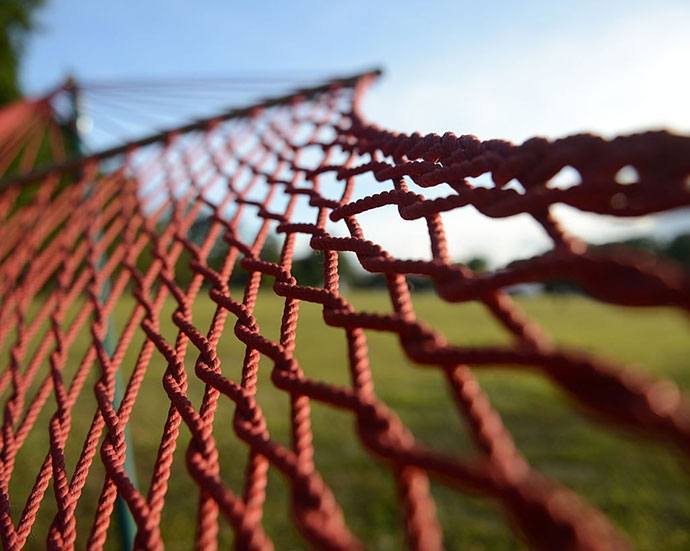There is nothing more rejuvenating than lounging in a hammock and absorbing much-needed vitamin D with a mimosa in hand.
In fact, some studies have shown that rocking motion can help trigger a peaceful sleep, making it one of the most rejuvenating naps you can ever experience.
In a few steps, we will explain to you how to make a rope hammock, and relax like never before.
The processes involved are not as complicated as you probably think, and by following the steps in this article, you will be swaying weightlessly in no time.
More...
Materials Needed
To make a one-person hammock, you need:

Then, you need to find a comfortable spot, with a nail or knob and a handy hook, hang your work on, and begin.
Step 1: Casting the Hammock
First, cut a 3-foot length of twine, and square-knot both ends together. This is the starter loop that should be hung from a knob or handy nail. Wind the netting shuttle that is full of twine, and then tie the free shuttle cord end to your starter loop that has an overhand knot.
Second, put the gauge stick behind the cord of the shuttle, up against the starter loop. To the back of the stick draw the shuttle, and pass that through your starter loop. Put it back down to the front of the stick. Pinch the twine taut against the stick with your left thumb for a secure hang.
In front of the stick raise the shuttle, then around both strands make a half hitch in the starter loop. To the front of the gauge stick pull the twine, and gradually let go with your left thumb, tightening the half hitch as you let go. Congrats, your first class on stitch is complete!
Repeat this process by bringing the shuttle around, up in the back of the stick, pass it through the starter loop, etc. repeat this procedure until you have made 20 snug and even loops on the gauge stick (make it 30 snugs for a two-person hammock).
Remember to make your half hitches in the same direction every time (this is to ensure that the “over” strand is taken from the same side always). This will make your work smooth.

Step 2: Making the First Row of Your Hammock
This stage is where you flip the gauge stick over to make the shuttle cord hangs on the left side (working from left to right on the rows).
Pull out the stick, letting the loops dangle free, hold the gauge in your left hand under the work, and bring the shuttle and its cord down in front, just behind the first cast-on (not starter) loop, bring it down in front of the stick again.
This shuttle should then be passed through the second cast-on loop as before. Repeat this process through each cast-on loop and ensure the work is even.
In no time, you will exhaust all of the cord on the shuttle. Reload, and knot the free end of your new twine to the previous cord, using a weaver’s knot.
Step 3: Knotting the Rest of the Hammock
When you reach the end of the first row, flip the work over, as you will do after finishing each row, then proceed as before. This process should be repeated until you net the length you want (54 rows is equal to about 7 feet of netting).
After completing the second row, cut the starter loop and remove it from the cast-on loops.
Support your work using a sturdy dowel or any convenient means, but ensure that the piece is held evenly.
Step 4: Mounting Your Hammock

For a two-person hammock, drill 20 holes through each of the two hardwood bars about 1-1/2 inches apart on center and from the beginning, and 2-1/4 inches from each end. Ensure the end holes are 1/4 to 5/16 inches in diameter, while every other hole should measure 3/16 to 1/4 inches.
Having done that, cut four cords, each having the following diameters: 46, 47, 48, 49, 50, 51, 52, 54, 56, 58 inches, making a total of 40 pieces or 20 per each end of the hammock. (For a double model, cut the same lengths, and additional four each of 60, 62, 64, 66 and 68 inches, making 60 pieces in all.)
These cords will form a fan-shaped array of strings in between the end rings (which you will hang the hammock on) and your supporting hardwood bars. The longest cords will be secured to the outside holes in each bar. These strings will get shorter as it approaches the center.
It’s time to get back to tying, loop one of the four longest cords on a metal ring using a lark’s head knot, then thread both ends through the outermost hole on one of the bars.
Fasten the cord to the top left-hand loop of your hammock mesh, by using a double half hitch. Then secure each cord in turn from the ring through the support-bar hole, to a loop the net.
Once all the 20 strings have been completed, repeat the same procedure for the other end of the hammock.
Finishing Up

To round up this “knotty” chore, you need to make a pair of three-cord braids. You need this to add firmness to the hammock’s edges. It is important to make each braid 3 inches shorter than the expected stretched-out length of the netting. Be generous when cutting the twine. Remember that the cords are likely to be least 10 percent shorter after braiding.
The three ends should be tied together with an overhand knot, thread the loose ends, passing it through an outside hole of one hardwood bar, and braid the cords. Next, create a loose knot at the end of the braid and weave it in through the outer meshes of the net.
Finally, undo the loose knot, and thread the braid through the outside hole of the bar to the other side of the hammock, and make a tight overhand knot to keep it in place. This process should be done on the other side as well.
It’s time to hang – hang your hammock between two poles or trees, and have a rejuvenating nap!

hammock 2500 x 2250 cm.
I have a rope hammock with the above Dimensions also have a stand for it. Unfortunately, the ropes in the middle are used up
I would like to have a new one. Can you offer me
or where can I find you, live in Capetown.
KR Barbara
Is there any chance you could share some photos of the steps. Having never done this before I feel like most of the steps make sense but I’m missing critical parts. Thank you
What is the weight capacity of this hammock?
Thank you for sharing your wisdom and explaining how to craft a rope hammock. I have a quick question and a request.
How many feet of rope will it take to make a 2 person hammock?
Also, I was wondering if it will be possible to send me or post more pictures so I can have an idea what exactly I’m supposed to be doing? I appreciate your time and guidance. God bless.